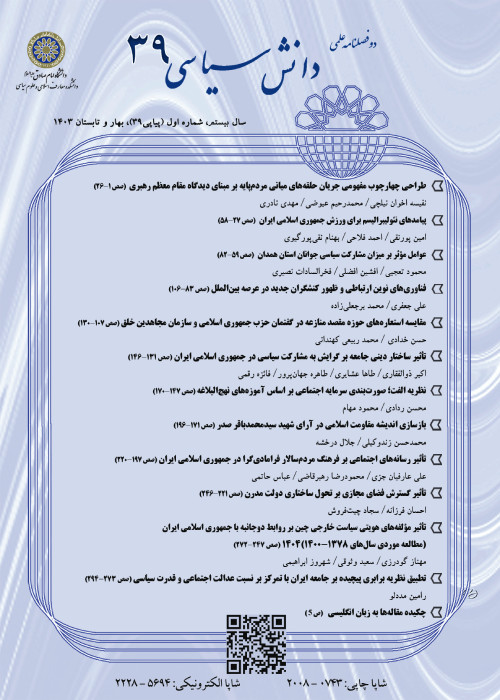Structural and agency backgrounds of the Nationalization Movement of the Oil Industry and the Islamic Revolution of Iran
Author(s):
Article Type:
Research/Original Article (دارای رتبه معتبر)
Abstract:
The main question of the paper is what the structural and agency backgrounds of the Nationalization Movement of the Oil Industry and the Islamic Revolution of Iran are. To answer this question, Anthony Giddens' Structuration Theory has been used. For Giddens, the structure and agency are two sides of a coin, and the integrated analysis of the structure- agency must be used to explain social phenomena. The method of this research is documentary and historical analysis, and a note -based tool for collecting information is used. The research hypothesis is that the simultaneous presence of structural and agency causes the occurrence of the National Oil Movement and Islamic Revolution movement. The findings of this research show that in the structural aspect, the most important factors in the national oil movement are: in the economic dimension the oil issue, in the social dimension, the coalition of clerics, intellectuals and marketers, in the field of domestic politics, the dictatorship of government and in foreign policy, the support of the super powers of the Mohammad Reza king, and in the cultural field, the dominant ideology of nationalist ideology. In the structural aspect, the most important factors in the Islamic revolution are: in the field of economy, dependent and uneven development and the rentier state, in the social dimension, the coalition of all classes, in the field of domestic politics, the absolute dictatorship mode of government, and in the foreign policy, dependence of Shah government on super powers, and in the cultural dimension, the dominant and mobilizing ideology of Shi'ism.
But in the agency aspect, in the National Movement, the coalition of Dr. Mossadegh as a representative of the national flow and Ayatollah Kashani as a representative of the religious flow, was effective. In the Islamic Revolution, there was again a coalition between religious, intellectuals and market forces, but the unique leadership of the revolution was by Imam Khomeini and religious flow as the main agents of it.
But in the agency aspect, in the National Movement, the coalition of Dr. Mossadegh as a representative of the national flow and Ayatollah Kashani as a representative of the religious flow, was effective. In the Islamic Revolution, there was again a coalition between religious, intellectuals and market forces, but the unique leadership of the revolution was by Imam Khomeini and religious flow as the main agents of it.
Language:
Persian
Published:
Political Knowlwdge, Volume:14 Issue: 1, 2018
Pages:
61 to 90
magiran.com/p1926459
دانلود و مطالعه متن این مقاله با یکی از روشهای زیر امکان پذیر است:
اشتراک شخصی
با عضویت و پرداخت آنلاین حق اشتراک یکساله به مبلغ 1,390,000ريال میتوانید 70 عنوان مطلب دانلود کنید!
اشتراک سازمانی
به کتابخانه دانشگاه یا محل کار خود پیشنهاد کنید تا اشتراک سازمانی این پایگاه را برای دسترسی نامحدود همه کاربران به متن مطالب تهیه نمایند!
توجه!
- حق عضویت دریافتی صرف حمایت از نشریات عضو و نگهداری، تکمیل و توسعه مگیران میشود.
- پرداخت حق اشتراک و دانلود مقالات اجازه بازنشر آن در سایر رسانههای چاپی و دیجیتال را به کاربر نمیدهد.
دسترسی سراسری کاربران دانشگاه پیام نور!
اعضای هیئت علمی و دانشجویان دانشگاه پیام نور در سراسر کشور، در صورت ثبت نام با ایمیل دانشگاهی، تا پایان فروردین ماه 1403 به مقالات سایت دسترسی خواهند داشت!
In order to view content subscription is required
Personal subscription
Subscribe magiran.com for 70 € euros via PayPal and download 70 articles during a year.
Organization subscription
Please contact us to subscribe your university or library for unlimited access!


